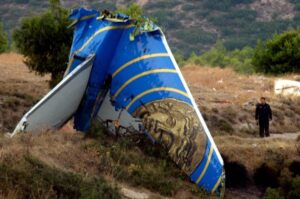The tragic accident that occurred to Helios Flight 522 on 14 August 2005, has left a deep impact on the aviation industry. To learn about what happened in this tragic flight, read here. There are many things that we can learn and take away from this, to improve and move forward to a safer aviation environment.
Manufacturer & Operator
Firstly, the operator and manufacturer play a part in ensuring safety within their organisation as well as passengers. They must continuously update their manuals and systems if discrepancies are found and authorities must enforce the implementation of corrective action plans after relevant audits. Aviation authorities should also ensure that corrective plans are implemented after audits are carried out. If authorities fail to intervene, similar accidents can occur again. Operators and manufacturers should be held accountable if the corrective actions are not carried out completely.
During the investigation of Helios flight 522, many flaws were found within the operator organisation. Many safety deficiencies were found within the management system and safety culture of the operator. Inadequate quality system, operational management control, quality and operations manual, corrective actions on audit findings, monitoring of pilot certificates and training are among some of the things that were found lacking. The most important however was the pressurisation section in the After Take-off checklist in the operator’s quick reference handbook (QRH) which was not updated as per the latest Boeing revision. Resulting in vague and incomplete instructions. Additionally, the manuals, SOP and training failed to address the actions required of the cabin crew if the following situation occurs, oxygen mask has been deployed at a high altitude or during climbing and the aircraft did not start to descent or level out and that no relevant information has been passed from the cockpit crew regarding the deployment of the oxygen mask. These inadequacies can result in further incidents and accidents if not dealt with.
The Manufacturer on the other hand was inconsistent with good human factors principles and did not have enough redundancy in the SOP and manuals in an event of omissions and mistakes by the flight crew. This was seen when the ground engineer left the selector on ‘MAN’ after a pressurisation check. Upon investigation, it was found that the manufacturer did not specify in the Aircraft Maintenance Manual to turn the selector back to ‘AUTO’ after such checks. Additionally, a warning horn would go off for 2 drastically different issues. The first is incorrect takeoff configuration and the other cabin pressurisation warning. Before the accident, there have been many reports regarding the confusion caused by the warning horn and pressurisation issues on the 737-300 model. Though measures were taken by the manufacturer, these measures with insufficient and ineffective in preventing similar accidents and incidents. They failed to ensure that their response solves those issues and prevents them from happening again.
Human Factors
Secondly, complacency is a human factor that often results in aviation incidents and accidents. Thus, crew members must always stay alert and not let their guard down as errors can occur at any time. Complacency is defined as feeling satisfied with one’s self and actions and is often accompanied by a loss of awareness. This feeling of complacency can often be seen when conducting routine activities where an individual may feel that this activity is safe and easy as it is done repeatedly. This results in the loss of vigilance. As skybrary explains, the lack of vigilance will cause important signals to be missed and the individual will only see what he/she expects to see.
This incident can be seen during the Helios flight 522 accident where the crew members failed to realise that the cabin pressurisation mode selector was on ‘MAN’ despite 3 checklists, the preflight checklist, before start checklist and after takeoff checklist. The reduction of attentiveness that comes from complacency can also occur after an intense activity such as recovery from potential danger and accident. After such intense activity, crew members may feel a sense of relief and end up reducing vigilance and alertness. During the investigation, the flight crew identified the cause of the Master Caution to be insufficient cooling of equipment and did not check for any other indications that could cause the Master Caution to go off. As a result, they failed to recognise the cabin-altitude visual and aural warning and failed to realise that the oxygen mask has been deployed in the cabin despite indications on the overhead panels. Complacency was one of the factors that led to the accident.
Adequate Training
Cabin depressurisation can occur for a multitude of reasons. Thus, crew members must be able to recognise signs of hypoxia in the event the cabin depressurisation warning malfunction or if the oxygen mask failed to deploy automatically. Crew members should obtain the relevant training to cabin depressurisation which also include hypoxia training. Minutes before the accident, the Master Caution went off and the flight crew identified that the equipment cooling fail indicator went off but failed to realise that the cabin pressurisation fail indicator had also gone off. This was an error on their part. However, should the flight crew realise the initial signs of hypoxia, they would have taken the safe action by descending or deploying and using the oxygen masks. Additionally, the cabin crew could have identified the signs of hypoxia and alerted the cockpit crew.
According to Healthline (2019), minor symptoms of hypoxia are shortness of breath, coughing, headache and an increase in heart rate while a major symptom is confusion and disorientation. During the post-accident investigation, it was found that applied hypoxia training was absent at the operator organisation. Also, manuals, SOP and training did not state the actions required by cabin crew members if the oxygen masks have been deployed and there is no relevant announcement made from the cockpit crew. These are the discrepancies that are found in training that needs to be corrected. Hypoxia training should be made mandatory if not already.
References
AIR ACCIDENT INVESTIGATION & AVIATION SAFETY BOARD. (2006). ACCIDENT REPORT HELIOS AIRWAYS FLIGHT HCY522 BOEING 737-31S AT GRAMMATIKO, HELLAS ON 14 AUGUST 2005. https://reports.aviation-safety.net/2005/20050814-0_B733_5B-DBY.pdf
SKYbrary. (2014). The Human Factors “Dirty Dozen” – SKYbrary Aviation Safety. Skybrary.Aero. https://www.skybrary.aero/index.php/The_Human_Factors_%22Dirty_Dozen%22#Complacency






